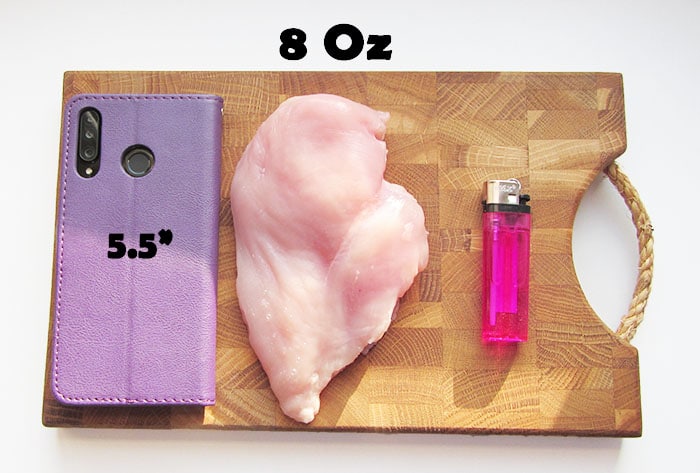Chicken breasts are included in many popular eating plans, especially when they’re designed for weight loss and muscle building. Its high-protein, low-carbohydrate combo works well in diets and it’s often more appealing than just eating vegetables alone. Chicken breasts are easy to prepare and eat. They are often the most tender meat of a chicken.
Many customers prefer to buy an 8-ounce chicken breast. For some of them, it is enough for a week, while serious athletes could consume it in a single day.
How big is an 8 Oz chicken breast?
I noticed that typical chicken breast size varies between 5 to 7 ounces. So, if you want to buy an 8 Oz piece of chicken breast, you should look for that one, which seems bigger.
Below, I added the picture to better understand what size boneless and skinless raw 8 Oz chicken breast looks like. As you can see, visually it’s similar to 5.5-inch smartphone dimensions. I hope this correlation allows you to quickly find the right size of chicken breast in the grocery store.

Protein in an 8 Oz chicken breast
According to different sources, an 8 oz raw chicken breast contains around 50 grams protein.
After cooking, however, 8 ounces of fried or baked chicken breast contains about 70 grams of protein.
If you need very accurate data, carefully check product labels before buying any product. I should admit that nutritional facts about the same product differ in available databases and on supermarket shelves.
Almost 80% of the calories you can get from 8 ounces of chicken breast come from protein. The remaining 20% of the calories are fat (more if the chicken breast has skin). When it comes to carbohydrates, chicken breasts have little to offer.
If you are not a fan of chicken breasts but still want to take advantage of their beneficial protein, you can replace them with chicken thighs. The thigh offers enough protein with the additional benefit of providing more nutrients. It is also cheaper—you just need to deal with a bone when preparing or eating.
Another alternative is shrimp. You will get around 50 grams of protein and only 4 grams of fat eating 8oz of shrimp.
Salmon is also a good replacement for chicken breast. A serving of 8 ounces of salmon provides 46 grams of protein. It does contain a bit more fat than chicken breasts. Salmon also lacks carbohydrates (46% fats, 54% protein, and 0% carbohydrates).
Does it provide enough protein?
On average, 70 grams are enough to provide your
However, your body requires more to exercise intensely and also during low carb diets. In these cases, you even need to double your protein intake.
8 Oz chicken breast nutrition facts
Together with consuming chicken breast protein you also receive other essential nutrients e.g. vitamins and minerals.
Here, I collected information about the main nutrition values that an 8 Oz chicken breast can provide us.
- Energy 272 calories
- Protein 50 grams
- Fat 6 grams
- Carbs and fiber 0 grams
- Potassium 754 milligrams
- Phosphorus 482 milligrams
- Choline 186 milligrams
- Sodium 101.6 milligrams
- Calcium 11.3 milligrams
- Magnesium 63.2 milligrams
- Zinc 1.5 milligrams
- Iron 0.84 milligrams
- Selenium 52 micrograms
- Vitamin A 20.4 micrograms
As you see, the chicken breast is rich in potassium, phosphorus, choline, and selenium. Each of them plays a significant role in many bodily functions. Let’s take for instance a trace mineral selenium. It acts as an antioxidant to help in lowering oxidative stress and prevent cell damage from free radicals. Selenium also could reduce the risk of certain types of cancer.

Share this Image On Your Website
Reference
- Chiken nutrition retrieved from: https://www.nutritionix.com.
- Chicken, broiler or fryers, breast, skinless, boneless, meat only, raw.







Leave a Reply